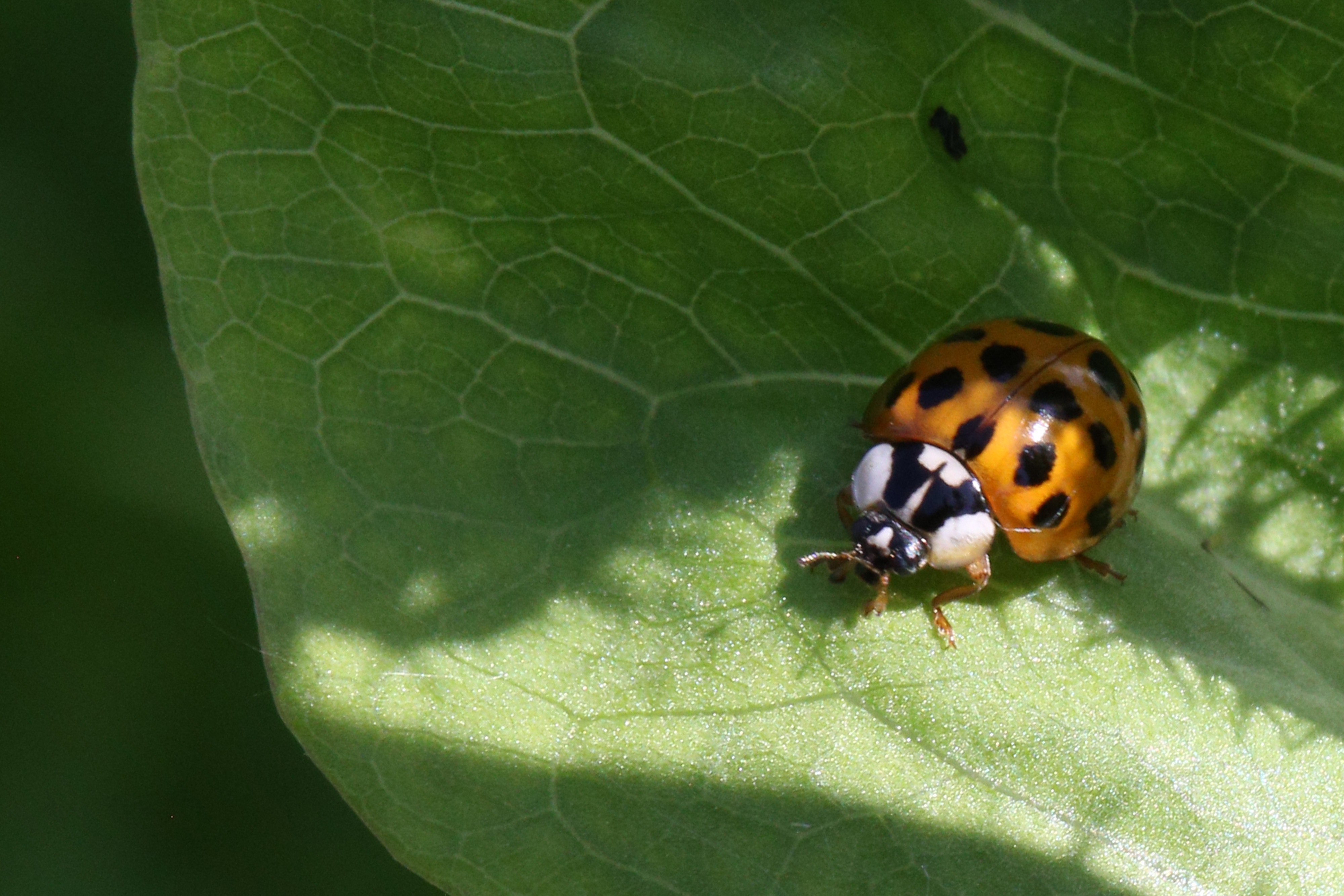Have you suddenly noticed an influx of what appear to be ladybugs in and around your home? You’re not alone. It’s a common occurrence this time of year, and while you might be calling them ladybugs, you’re likely encountering Asian lady beetles.
While these beetles can be a bit of a nuisance, especially when they gather in large numbers, it’s important to understand why this happens and what, if anything, you should do about it.
What are Asian Lady Beetles?
According to experts at the University of Minnesota, Asian lady beetles, scientifically known as Harmonia axyridis, are often mistaken for common ladybugs. They do share similarities, but Asian lady beetles tend to be slightly larger. Their color range is also broader, typically seen in shades of orange or yellow, though they can also appear red or, less commonly, black.
A key characteristic to help distinguish them is their spots. While they can have up to 19 black spots, some may have fewer or even none. Look closely behind their head – Asian lady beetles have a distinctive “clear black ‘M’-shaped marking” which is a reliable identifier.
These beetles are also known by other names, including Halloween lady beetles and Japanese lady beetles, reflecting their seasonal appearance and origin.
 Asian lady beetle, Harmonia axyridis, on a green leaf in Markham, Ontario, Canada.
Asian lady beetle, Harmonia axyridis, on a green leaf in Markham, Ontario, Canada.
An Asian lady beetle, Harmonia axyridis, rests on a green leaf in Markham, Ontario, Canada.
Why are there so many of them right now?
The sudden appearance of Asian lady beetles in homes is most noticeable in the fall. Peggy Anesi, a natural resources, environment, and energy educator at the University of Illinois, specializing in wildlife management, explains this phenomenon.
“Like many insects, the lady beetle starts seeking small crevices to gather in large numbers and begin diapause, the name for insect hibernation,” Anesi noted in a university blog post. Essentially, as the weather cools, these beetles are looking for sheltered places to spend the winter. Unfortunately for homeowners, this often means our houses. “They often inadvertently crawl into basements through cracks in the foundation,” she adds.
The sheer number of beetles can be alarming. Anesi recounts, “The Asian lady beetle’s self-invitation causes my phone to ring as early as Halloween. Most people, not so much a naturalist, won’t tolerate even a single bug in the house so imagine the call when someone locates an entire yard full of lady beetles in the corner of their basement.”
The University of Minnesota further clarifies that “once lady beetles move into wall voids in the fall there is no way to prevent them from emerging later during winter or spring.” This means that once they find their way in, they might reappear indoors throughout the colder months.
Are they harmful?
Fortunately, while their presence can be unsettling, Asian lady beetles are generally not harmful to humans or pets. The University of Minnesota emphasizes that they “can be a nuisance when they occur in large numbers inside homes,” but they do not pose a significant threat.
They won’t damage your property, and they are incapable of stinging. However, they can bite, although this is usually in self-defense or if they are searching for moisture or food on your skin. A more common complaint is their defensive secretion – a “strong-smelling yellowish liquid” that can stain light-colored surfaces.
Anesi describes this defense mechanism vividly: “If you disturb any lady beetle, you will be amazed at the amount of foul smell from a yellow discharge they can admit through their leg joints. This is their defense mechanism that keeps other animals from wanting to snatch them up.”
Despite being a household nuisance, Asian lady beetles are beneficial in outdoor environments like wooded areas and gardens. They are natural predators of garden pests, especially aphids. However, if their aphid food source dwindles, they may seek alternative food sources, including ripe fall fruits like grapes and apples, sometimes infesting damaged fruit.
Can you prevent these beetles from infesting your home in the fall?
Preventing Asian lady beetles from entering your home in the first place is the most effective approach. Experts recommend focusing on sealing potential entry points before they seek shelter for the winter. It’s important to act before the end of September, as these beetles can squeeze through surprisingly small openings, as tiny as 1/8-inch.
Here are preventative measures recommended by the University of Minnesota:
- Inspect your home’s exterior: Thoroughly check for cracks and spaces that could allow insects entry. Remember, lady beetles can fit through openings as small as 1/8 inch.
- Seal cracks and openings: Make necessary repairs and sealing by the end of September. Pay close attention to areas around doors, windows, and fascia boards. Look for gaps where different materials meet, such as brick and wood siding.
- Use appropriate sealants: Seal cracks with caulk, choosing options like silicone, elastomeric latex, or silicone/acrylic.
- Seal utility entry points: Address areas where cable TV wires, phone lines, utility wires, pipes, outdoor faucets, and dryer vents enter the building. Seal these with caulk, or for larger gaps, consider polyurethane expandable spray foam, steel wool, copper mesh, or other suitable sealants.
- Maintain screens: Repair or replace damaged window and door screens. Also, check and repair or replace damaged screens in roof and soffit vents, as well as bathroom and kitchen fan vents.
- Install door sweeps and thresholds: Install door sweeps or thresholds on all exterior entry doors. For garages, install a rubber seal along the bottom of garage doors.
While some experts suggest using pesticides on the exterior of your home as a preventative measure, others believe it’s “unnecessary” and potentially harmful to other beneficial insects. Focusing on physical barriers is generally considered a more environmentally friendly and sustainable approach.
Asian lady beetles congregate in large numbers on a house exterior in autumn.
What can you do if they’re already in your home?
Once Asian lady beetles are inside, spraying pesticides is generally ineffective and not recommended. Experts have varying opinions on the best method for removing them from indoors.
Anesi suggests simply sweeping them out. However, she cautions against vacuuming large numbers, “because if you vacuum up a pile of them in the winter the smell will make you change the vacuum bag before it’s full.” The odor from their defensive secretion can be quite potent and linger in your vacuum.
The University of Minnesota, while acknowledging the smell issue, suggests vacuuming as a viable option. They recommend changing the vacuum bag frequently to minimize odor. For a more contained approach, they advise: “You may use a knee-high nylon stocking that has been inserted into the extension hose and secured with a rubber band. As you vacuum, the lady beetles are captured in the stocking. Remove the stocking after vacuuming, so the captured beetles won’t escape.” This method helps to collect the beetles while reducing the smell and preventing escape back into your home.
While the appearance of large numbers of ladybugs – or more accurately, Asian lady beetles – can be a temporary fall nuisance, understanding their behavior and implementing preventative and removal strategies can help manage their presence in your home. They pose no real harm and are a sign of changing seasons.
References:
- University of Minnesota Extension: https://extension.umn.edu/nuisance-insects/multicolored-asian-lady-beetles
- University of Illinois Extension – Naturalist News Blog: https://extension.illinois.edu/blogs/naturalist-news/2022-01-07-asian-lady-beetles-move-indoors-winter
